Key takeaways:
- Wildlife education fosters curiosity and empathy in children, transforming them into advocates for nature through personal experiences.
- Creative and hands-on activities, such as art projects and habitat restoration, enhance emotional connections to wildlife and encourage stewardship.
- Storytelling effectively captivates children’s attention and instills values of empathy and responsibility towards animals and conservation efforts.
- The Animal Protection Society plays a crucial role in providing resources and partnerships that promote wildlife education and empower young activists.
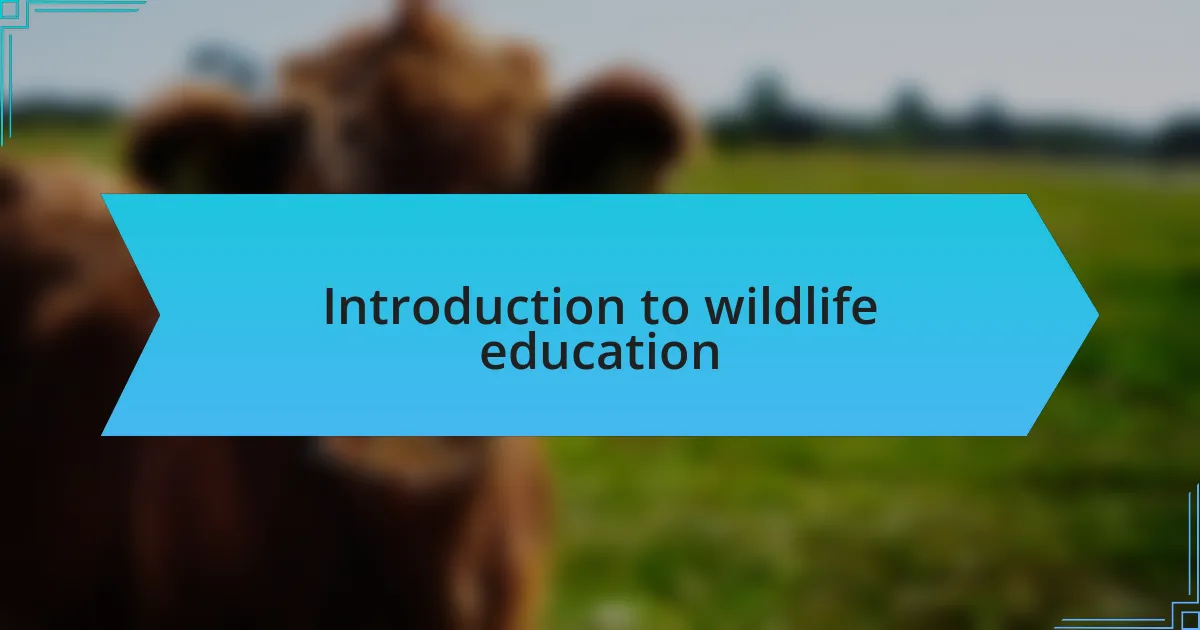
Introduction to wildlife education
Wildlife education serves as a vital bridge between the natural world and young minds. I remember the first time I took a group of kids on a nature walk; their eyes lit up with curiosity as they spotted a family of deer in the distance. That moment highlighted the importance of instilling a sense of wonder and appreciation for wildlife in children.
Understanding wildlife is more than just facts; it’s about fostering connections with the environment. When children engage with animals and their habitats, they begin to realize why conservation is essential. Have you ever watched a child crouch down to observe an ant on the ground? It’s those small yet significant interactions that plant seeds of empathy and curiosity.
Moreover, wildlife education is not solely about awareness; it empowers kids to be advocates for nature. I’ve witnessed children who, after learning about endangered species, passionately campaign for their protection. These experiences demonstrate that when children are encouraged to care about wildlife, they often take meaningful action. Isn’t it inspiring to think about the future of our planet in the hands of these young advocates?

Importance of wildlife education
Wildlife education is crucial because it lays the foundation for a deep-rooted respect for the environment. I remember hosting a workshop where children painted local birds, and through the process, they expressed feelings about how important these creatures are to our ecosystem. This experience made me realize that creative activities can help children form emotional connections with wildlife, making them more likely to value and protect it.
When kids learn about the struggles of endangered species, it becomes a personal story rather than just a statistic. I once spoke with a young attendee who felt a genuine sense of loss upon hearing about the plight of the polar bear. This emotional response often sparks a desire to take action, illustrating that wildlife education can ignite a lifelong passion for conservation. How can we not be moved by the idea that awareness can transform young hearts into future guardians of nature?
Additionally, understanding the complexities of ecosystems fosters critical thinking and responsibility. During a simulation game on habitat preservation, I watched as children negotiated their roles and responsibilities in keeping their environment healthy. Their chatter reflected genuine concern and valuable insights, reshaping their understanding of their impact on the world. Wouldn’t it be amazing if all kids approached wildlife with such responsibility and foresight?
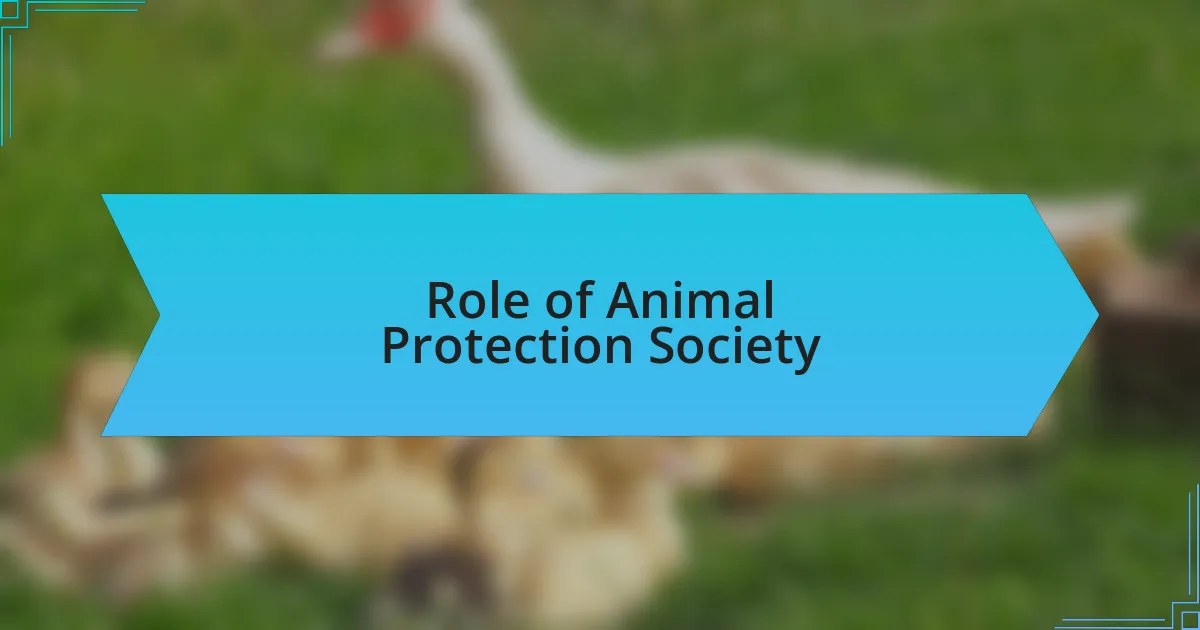
Role of Animal Protection Society
The Animal Protection Society plays a pivotal role in fostering a strong foundation for wildlife education. From leading engaging seminars to producing accessible educational materials, the Society ensures that vital information reaches young minds in captivating ways. I recall attending a local fair where the Society set up a booth, showcasing interactive displays that drew in curious kids, sparking conversations that extended well beyond the event.
Moreover, partnerships with schools create a direct line of communication between conservationists and students. I’ve seen firsthand how schools that collaborate with the Society incorporate wildlife topics into their curriculums, allowing children to explore real-world conservation efforts. In one memorable project, a group of students helped design a protection plan for local endangered species, which ignited a newfound commitment among them to advocate for these animals. Isn’t it inspiring to think how such initiatives can motivate young activists?
Through hands-on experiences and community involvement, the Animal Protection Society empowers children to become informed advocates for wildlife. I remember volunteering for a habitat restoration event, where young participants dug in the dirt while learning about the interconnectedness of species. The sparkle in their eyes as they unearthed living organisms made it clear that this pragmatic approach engages them on a profound level. How can we not feel encouraged by the thought that these experiences cultivate a generation ready to champion wildlife?
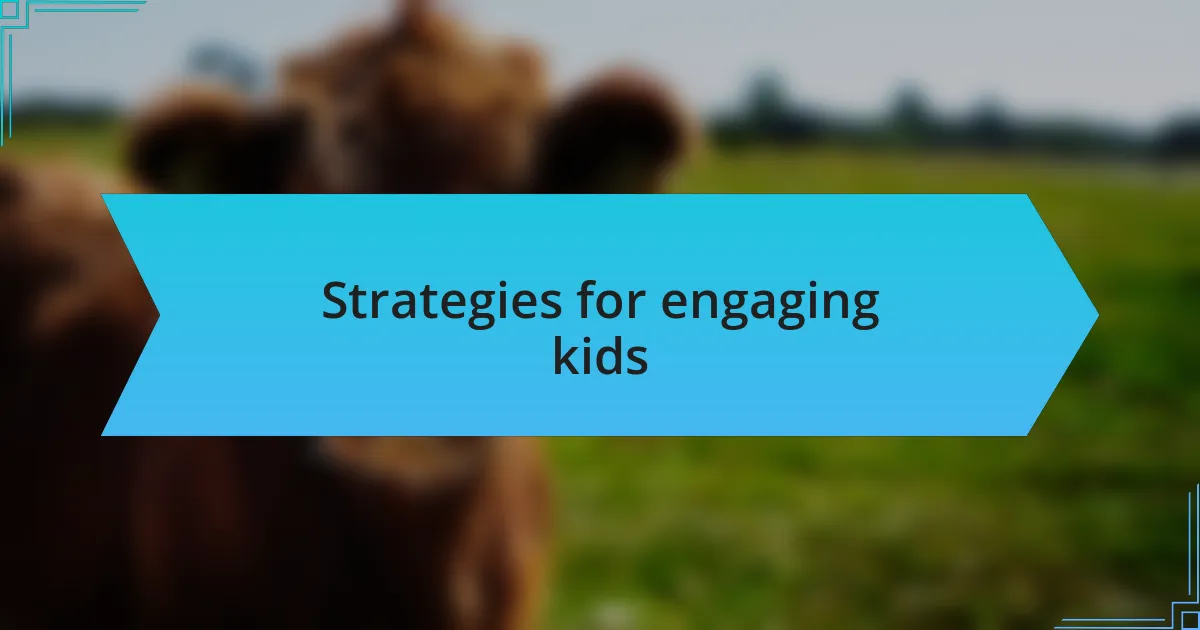
Strategies for engaging kids
One effective strategy for engaging kids in wildlife education is through interactive activities. I vividly remember a time when I organized a nature scavenger hunt. We printed colorful checklists filled with local wildlife, and the excitement was palpable as kids dashed around, eagerly searching for clues. Their enthusiasm transformed learning into an adventure, illustrating how hands-on experiences can spark curiosity and deepen their connection to nature.
Storytelling is another powerful tool that resonates with children. When I shared animal tales during a weekend workshop, I watched how their imaginations flourished. Kids were captivated by the stories of endangered species and their struggles, which prompted them to ask questions and express empathy. Isn’t it fascinating how narratives can weave emotional threads that connect young minds to conservation issues?
Additionally, utilizing technology can elevate a child’s engagement with wildlife. I once led a group in a virtual reality experience that placed them in the heart of a rainforest. The thrill on their faces, coupled with the chance to see endangered animals up close, showcased how innovative approaches can make the subject matter memorable. How often do we consider the impact of modern tools in fostering a new generation of wildlife advocates?
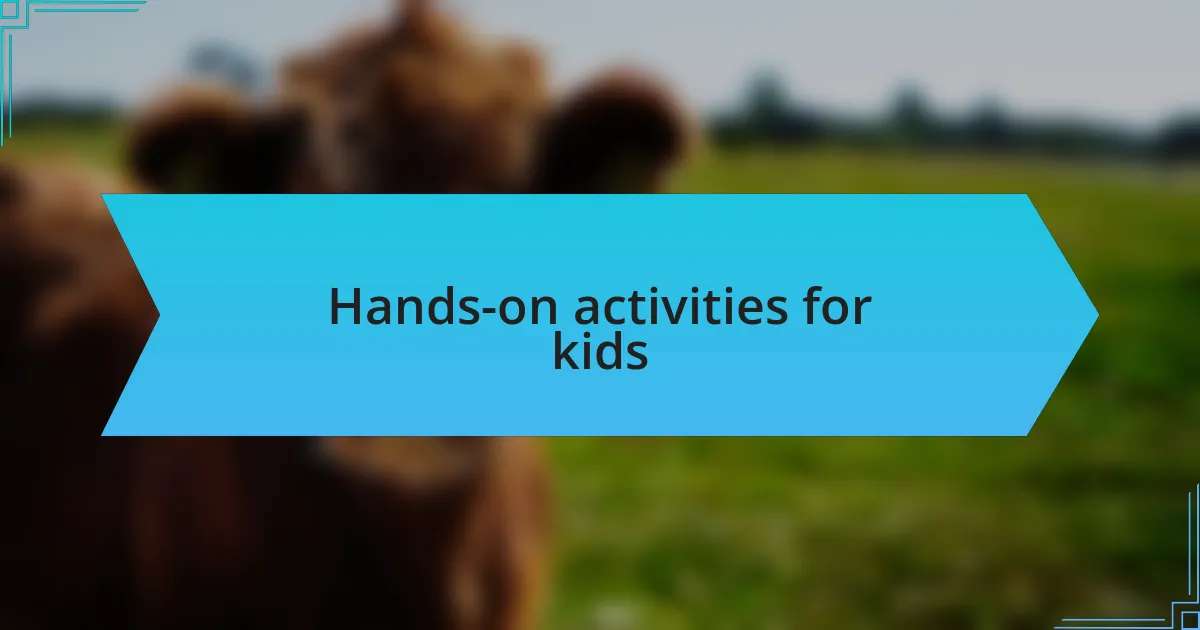
Hands-on activities for kids
Engaging kids through hands-on activities can create memorable learning experiences. I once set up a mini wildlife habitat in my backyard, where children could explore different ecosystems. Watching them build little homes for frogs and insects, while learning about biodiversity, was truly rewarding. Isn’t it incredible how they instinctively understood the importance of creating safe spaces for wildlife?
I’ve also had success with simple art projects focused on animals. After a visit to a local sanctuary, I gathered the kids for a drawing session where they illustrated their favorite animals. The excitement in their voices as they shared facts about each creature was inspiring. It made me realize that creativity allows them to express their newfound knowledge in ways that stick with them long after the paint dries.
Another engaging idea is to involve kids in actual wildlife monitoring. I remember coordinating with a local conservation group to train kids on how to identify and track bird species. The sense of responsibility they felt in contributing to real research fostered a genuine connection to their local environment. How often do we give kids the opportunity to be part of something bigger than themselves?
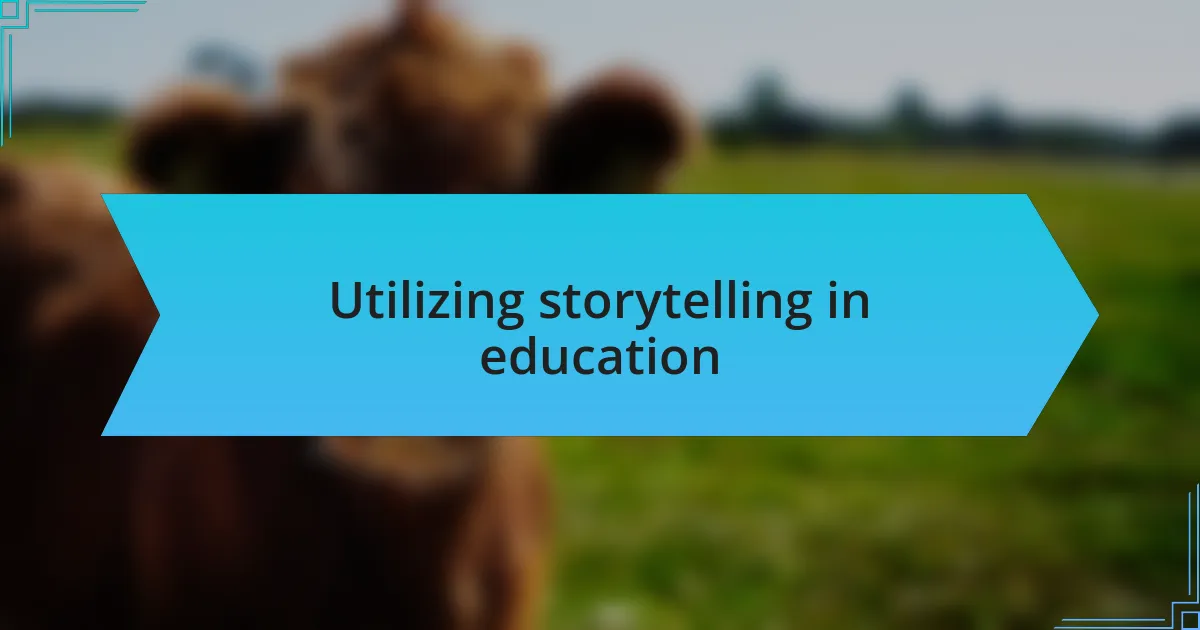
Utilizing storytelling in education
When I first introduced storytelling into my wildlife education sessions, I was amazed by the immediate shift in engagement levels. I gathered the kids around a campfire and shared tales of heroic animal rescues and natural wonders. The thrill in their eyes as I described a baby sea turtle battling the waves made me realize that stories can transcend mere facts, turning lessons into adventures.
One day, I recounted the story of a lioness who fought to protect her cubs from danger. The intensity of those moments sparked a discussion about the values of courage and family in the animal kingdom. I noticed how the children connected emotionally, asking questions like, “What do you think happened next?” It was a powerful reminder that storytelling not only captivates attention but also cultivates empathy for wildlife.
I also encourage kids to create their own animal stories, allowing their imaginations to soar. When a group of kids crafted a tale about a clever raccoon outsmarting a park ranger, they immersed themselves in the perspective of that raccoon. Seeing them so invested in their stories reminded me of the role that creative expression plays in shaping their understanding of nature. How can we hope to inspire stewardship for wildlife if we don’t first instill a sense of wonder?
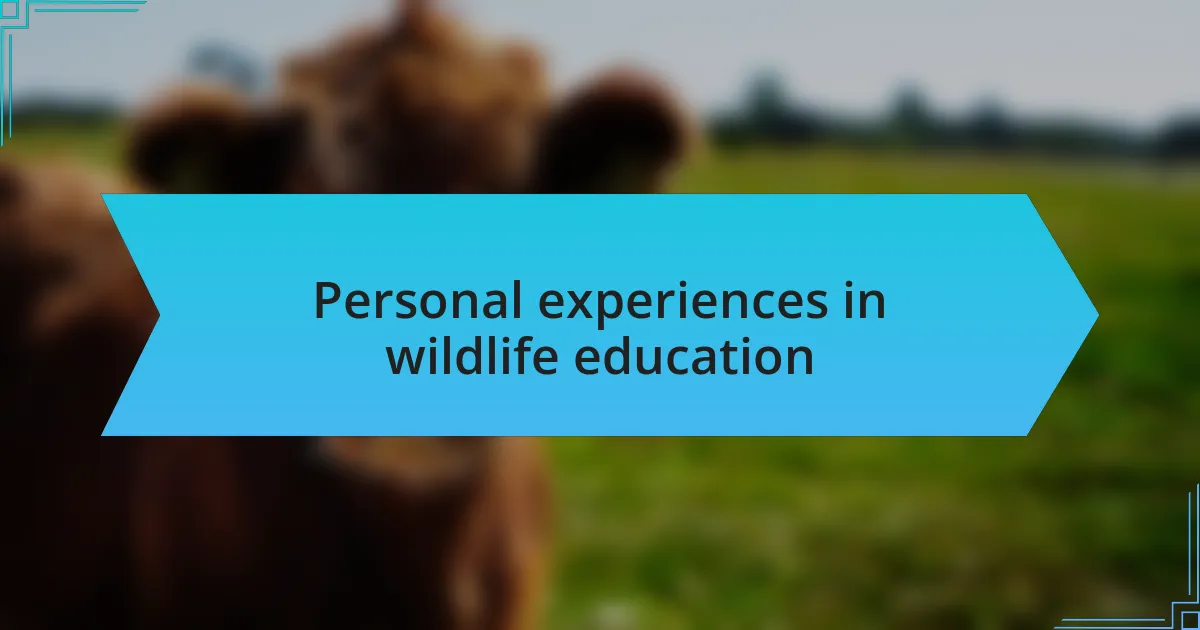
Personal experiences in wildlife education
One memorable experience I had was organizing a wildlife scavenger hunt in a local park. I provided clues relating to different habitats and the species residing within them. Witnessing the kids running through the grass, genuinely excited to find a hidden bird’s nest or track a deer left me feeling grateful; their connection to nature was palpable as they exclaimed over each discovery.
During another session, I brought along images of endangered species and shared personal stories about animals I had encountered in the wild. I remember one child, wide-eyed, asking why a particular species was endangered. This sparked an impromptu discussion about conservation efforts, leaving us all with a collective sense of responsibility. It reminded me that even simple conversations could plant the seeds of awareness and action in the next generation.
I find that hands-on experiences resonate deeply with kids. For example, when we built birdhouses together, the joy wasn’t just in creating something tangible; it was in discussing why birds need safe places to nest. Questions like, “What makes a good home for birds?” encouraged them to think critically about wildlife needs, and the satisfaction of watching our birdhouses filled with new tenants later was an experience none of us would forget.